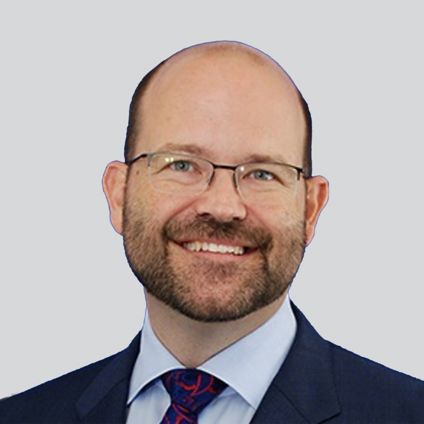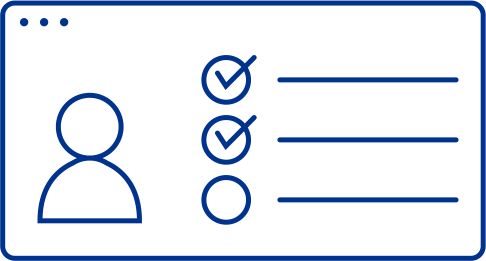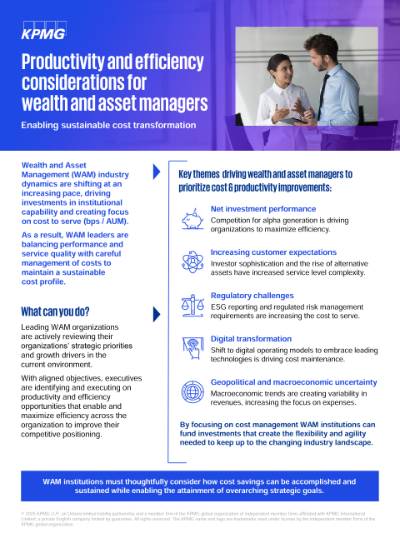Market volatility and cost pressures remain a reality for wealth and asset managers. Investors and their advisors are grappling with cost and margin pressures, sticky inflation, regulatory challenges and uncertainty around the rise of interest rates.
Under these circumstances, cost management remains a strategic objective at an enterprise level. The challenge that most organizations face is identifying where to find efficiencies in cost management without impacting distribution, growth or risk posture. Organizations are contemplating initiatives that consider multiple areas of operation, from improving back-office productivity to transforming front and middle office operations. Organizations must also focus on mitigating risks, reducing the cost to serve, and minimizing complexity within their structures. Today’s cost imperative is to find new efficiencies to manage cost whilst enabling the development of resilience and delivery high-quality client service.
The next frontier: From cost optimization to cost transformation
Cost management certainly isn’t a new agenda item for most wealth and asset management organizations, in fact, many organizations have initiated tactical cost optimization opportunities in recent years. These initiatives have focused heavily on operating model redesigns such as simplifying processes, exploring automation, removing duplicate roles, and limiting the use of external vendors to drive immediate cost reductions. Most organizations have also sought to drive cost transparency by focusing on cost allocation and ongoing cost visibility within their organizations.
However, the frontier for cost management has evolved. Wealth and asset management organizations increasingly see front and middle office transformation as their next strategic imperative. Wealth and asset management institutions must thoughtfully consider how cost savings can be accomplished and sustained while still working towards their overarching strategic goals.
Rising costs within the front and middle office operations
Front and middle office operations have continued to increase in cost over the last several years. We’ve identified three major market trends that are driving this cost increase:
- Asset class complexity: A major source of rising costs is the siloed approach to managing different and increasingly complex asset classes across Private and Public Markets. This is amplified by the emergence of new asset classes, a shifting investment focus, and global strategies.
- Technological complexity: Many wealth and asset management organizations continue to operate legacy technology systems with limited data and analytics capabilities. Organizations have been grappling with the cost of modernizing outdated infrastructure while also considering the impact and potential of “best of breed” or “hybrid platform” solutions. Embracing leading technologies and shifting to digital operating models is helping organizations drive cost maintenance.
- Risk posture: Regulatory expectations have driven operational resilience requirements for wealth and asset management executives. For instance, ESG reporting now carries a heavier load for sector leaders and comes with associated operating model and technology implications.
Making changes to front and middle office operational models
To address these challenges, wealth and asset managers are directing their cost transformation efforts to the front and middle offices, and are making two critical changes:
- Rethinking service delivery: Over the last five years, improvements in technology and increasingly complex processes to manage new asset classes have driven service delivery complexity and cost within front and middle office operations. Wealth and asset managers are looking to streamline functional processes through optimized workflows and leverage leading technologies such as generative AI to eliminate duplicative work and reduce the cost to service.
- Leveraging insourced / outsourced hybrid operating models: Another emerging theme is leveraging a hybrid operating model with both insourced and outsourced capabilities. When an organization identifies and outsources its non-critical processes and capabilities, its in-house talent stays focused on value-add activities. The hybrid approach builds resilience, upholds quality, and grows potential over the long term by keeping strategic and core-focused capabilities inside the organization. Furthermore, it integrates and optimizes existing technology platforms and architecture through a modular approach which can be further modified, optimized, and improved.
Implementation challenges
Transformation is a journey, and for every organization, there will be new and unique challenges. Some of the main challenges wealth and asset management organizations are facing include:
- Resistance to change: The challenge of traversing existing departmental silos and developing new, cross-functional frameworks.
- Financial limitations: Shifting from an insourced model to a hybrid or best of breed technology platform requires a significant financial investment that may not be readily accessible.
- Transformation complexity: New asset class mixes have increased the burden on front office functions, while also raising expectations of what it can achieve.
Discover how leading wealth and asset management organizations are enhancing their competitive positioning through strategic cost optimization and productivity improvements.
How we can help
KPMG's wealth and asset management advisory team offers a comprehensive approach to help organizations to help enhance productivity and efficiency. By focusing on strategic frameworks, operational transformations, technology optimization, cost management, digital solutions, regulatory compliance, and efficiency opportunities, KPMG aims to support Wealth and Asset Management institutions in achieving their business objectives and building resilience in a rapidly changing industry landscape.
Here's how we can help wealth and asset managers meet their business objectives and build resilience:
- Strategic framework and options analysis to assess the potential and opportunity for change within your organization.
- Transform front and middle office operations driven by tactical operational cost and productivity improvement opportunities or by engaging a strategic servicing provider.
- Develop a contemporary architecture platform that leverages the best of an organization’s existing technology capabilities while enabling growth, optimizing cost, and minimizing risk.
- Define and implement a culture of cost management by identifying, capturing, and reinvesting savings within the organization to help focus on long-term value creation through strategic cost management.
- Shift to digital operating models to embrace leading technologies to help drive cost maintenance.
- Navigate complex regulatory environments to help ensure compliance while optimizing operations.
- Identify and quantify efficiency opportunities through workshops and collaboration to help uncover specific areas for improvement and cost savings.
For assistance navigating cost transformation in wealth and asset management, connect with us.
Wealth and asset managers must act now on their middle office transformation and aspirations through effective cost optimization. They have an opportunity to reimagine their middle office operating models and embed leading technologies to reduce risk, streamline operations, and future-proof their operations.

This article is co-authored by Bosco Tong, Director, Wealth and Asset Management, KPMG in Canada and David Bardsley, Partner, Head of Wealth and Asset Management Advisory, KPMG in Canada.
Insights and resources
Connect with us
Stay up to date with what matters to you
Gain access to personalized content based on your interests by signing up today
Connect with us
- Find office locations kpmg.findOfficeLocations
- kpmg.emailUs
- Social media @ KPMG kpmg.socialMedia








